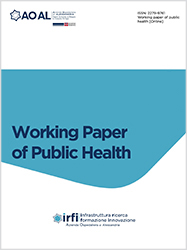Adoptive immunotherapy by Donor Lymphocyte Infusion (DLI) after allogeneic Hematopoietic Stem Cell transplantation and chimerism monitoring

Accepted: 6 September 2023
PDF: 41
All claims expressed in this article are solely those of the authors and do not necessarily represent those of their affiliated organizations, or those of the publisher, the editors and the reviewers. Any product that may be evaluated in this article or claim that may be made by its manufacturer is not guaranteed or endorsed by the publisher.
Objectives: the allogeneic Hematopoietic Stem Cell (HSC) transplant is an important treatment for patients suffering from hematological diseases as it can induce remission; however, disease recurrence is one of the most important causes of failure. Adoptive immunotherapy represents a new therapeutic approach against hematological cancers, alongside and sometimes replacing traditional therapies, such as chemotherapy and radiotherapy. The Donor Lymphocyte Infusion (DLI), or the infusion of lymphocytes from the same allogeneic HSC donor, is part of this therapy as they are intended to restore the defensive capabilities of the immune system, representing a possibility of a cure for the patient. A retrospective study in transplanted hematological patients, related to the SC of Hematology, was performed at the HSC Processing Facility of the SC Transfusion Medicine of the Santi Antonio e Biagio and Cesare Arrigo Hospital of Alessandria, in order to evaluate whether the monitoring of chimerism, performed on Peripheral Blood (PB), Lymphoid Line (L), Myeloid Line (M) and Bone Marrow (BM) pre- and post-infusion of DLI could inform the clinician about the efficacy of adoptive immunotherapy. Materials and Methods: the efficacy of DLI has been evaluated through the study of the monitoring of chimerism, which uses the Polymerase Chain Reaction – Short Tandem Repeats (PCR-STR) technique. This technique uses gene polymorphisms, STR, tandem repetitions of small nucleotide sequences that are repeated n times. There are three different situations: i) complete chimerism, donor cells are >90%; ii) mixed chimerism, coexistence in the recipient of own cells and those of the donor present in a range from 20% to 85%; iii) chimerism absent, autologous hemopoietic reconstitution, donor cells <20%. Results: a first analysis of the data shows that the distribution of patients within the various pathologies is uneven. It was therefore considered to divide patients according to the hematological pathology to which they belong. In patients with Acute Myeloid Leukemia (AML), the data obtained shows that 14 (54%) died due to complications despite the Donor Lymphocytes Infusion (DLI). The remaining 12 patients show a 46% survival rate. In Acute Lymphoblastic Leukemia (ALL) patients, the collected data shows that 4 patients died with a mortality rate of 50%. The remaining patients show a 50% survival rate in patients suffering from the remaining pathologies (Non-Hodgkin Lymphoma (NHL), Myelodysplasia (MDS), Hodgkin Lymphoma (HL), Multiple Myeloma (MM), and Chronic Lymphoblastic Leukemia (CLL). It is possible, therefore, to observe how, even in the case of this group of pathologies, the mortality rate is 50%. The remaining patients show a 50% survival rate. Of the 47 patients, 34 (72%) didn’t develop Graft versus Host Disease (GvHD) post-DLI, while 13 (28%) developed chronic or acute GvHD. Conclusions: our data agree with those in the literature that report how, after infusion of DLI, remission is around 15-42% for AML and between 40-60% for ALL, while the mortality rate is 50% for both. As for the remaining diseases, we observed that in the 13 patients examined, the mortality rate is 50%, comparable to the survival rate. In this group of pathologies, the role of DLI, in the literature is unclear. As for the development of GvHD post-DLI in the literature, it is around 50-60% of patients; our data show a lower value of around 28% for all the pathologies examined. The analysis of the collected data, although the size of the sample is small and there are many variables related to it, allows us to confirm its adherence to the works in the literature. We, therefore, think that the infusion of DLI is an important therapeutic weapon within the treatment strategies available to the hematologist.
Kaushansky K, Lichtman MA, Prchal JT, et al. Williams Hematology. Mc Graw Hill Education, 2016.
Sweeney C, Vyas P. The Graft-Versus-Leukemia Effect in AML. Front. Oncol. 2019;9:1217. DOI: https://doi.org/10.3389/fonc.2019.01217
Dazzi F, Szydlo RM, Cross NC, et al. Durability of responses following donor lymphocyte infusions for patients who relapse after allogeneic stem cell transplantation for chronic myeloid leukemia. Blood. 2000;96:2712. DOI: https://doi.org/10.1182/blood.V96.8.2712
Negrin RS. Immunotherapy for the prevention and treatment of relapse following allogeneic hematopoietic cell transplantation. 2022. Available from: https://www.uptodate.com/contents/immunotherapy-for-the-prevention-and-treatment-of-relapse-following-allogeneic-hematopoietic-cell-transplantation
Clark JR, Scott SD, Jack AL, et al. Monitoring of chimerism following allogeneic hematopoietic stem cell transplantation (HSCT): technical recommendations for the use of short tandem repeat (STR) based techniques, on behalf of the United Kingdom National External Quality Assessment Service for leukocyte immunophenotyping chimerism working group. British Journal of Haematology. 2015;168:26-37. DOI: https://doi.org/10.1111/bjh.13073
Butler JM. Advanced Topics in Forensic DNA Typing: Methodology. Elsevier Academic Press, San Diego, USA. 2012.
Solomon SR, Sizemore CA, Zhang X, et al. Preemptive DLI without withdrawal of immunosuppression to promote complete donor T-cell chimerism results in favorable outcomes for high-risk older recipients of alemtuzumab-containing reduced-intensity unrelated donor allogeneic transplant: a prospective phase II trial. Bone Marrow Transplantation. 2014;49:616-21. DOI: https://doi.org/10.1038/bmt.2014.2
Bader P, Niethammer D, Willasch A, et al. How and when should we monitor chimerism after allogeneic stem cell transplantation? Bone Marrow Transplantation. 2005;35:107-19. DOI: https://doi.org/10.1038/sj.bmt.1704715
Deol A, Lum LG. Role of donor lymphocyte infusions in relapsed hematological malignancies after stem cell transplantation revisited. Cancer Treatment Reviews. 2010;36:528. DOI: https://doi.org/10.1016/j.ctrv.2010.03.004
Loren AW, Porter DL. Donor leukocyte infusions for the treatment of relapsed acute leukemia after allogeneic stem cell transplantation. Bone Marrow Transplantation. 2008;41:483-93. DOI: https://doi.org/10.1038/sj.bmt.1705898
Copyright (c) 2024 Camilla Zani, Roberta Neri, Giuseppina Balza, Maria Grazia Verri, Marika Cagnati, Manuela Arata, Francesco Zallio, Paolo Rivela , Thea Bensi, Mauro Patrone, Lia Mele

This work is licensed under a Creative Commons Attribution-NonCommercial 4.0 International License.
PAGEPress has chosen to apply the Creative Commons Attribution NonCommercial 4.0 International License (CC BY-NC 4.0) to all manuscripts to be published.

 https://doi.org/10.4081/wpph.2023.9644
https://doi.org/10.4081/wpph.2023.9644




